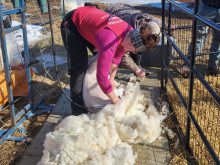BANFF, Alta. — Taiwan Sugar Enterprises may have moved too quickly when it tried to gain permission to build a mega-hog farm in Alberta, says the company hired to oversee the project.
“Some mistakes have been made along the way,” said Dennis Hodgkinson of DGH Engineering.
When the Taiwanese firm hired DGH as project manager in January 2000, it wanted to be building barns by spring 2001.
Manitoba-based DGH has worked on similar projects across Canada, although none as large as Taiwan Sugar’s proposed 7,200-sow facility.
Read Also

Charges laid after cattle theft
Saskatchewan RCMP lay two charges against a man after six cattle went missing.
The international food company chose to build in Alberta because it seemed to offer the best opportunities for pork expansion.
While Taiwan Sugar also does business in Australia and Vietnam, it is not fully satisfied with either arrangement.
Hodgkinson told a Jan. 25 session of the Banff Pork Seminar that Taiwan Sugar considered its Alberta project to be an experiment. More barns would be built if the Alberta project succeeded.
Misread community
Its first application to build in the County of 40 Mile was rejected because of widespread opposition. Company officials thought the project wouldn’t offend the sparsely populated community, but they were mistaken.
It received the go ahead in the County of Kneehill to start building this May, but construction could stop if the case is successfully appealed in court.
Hodgkinson said there are a number of ways to win public acceptance for an intensive livestock operation.
“You need a down and dirty public relations plan,” he said.
The plan needs to get under way before controversy starts so the community is assured environmental concerns have been thoroughly and responsibly addressed.
“You haven’t got a snowball’s chance in hell when you are embroiled in the controversy of development.”
Besides answers to health and environmental concerns, the public has to see an immediate benefit to the local community.
Details about long-term economic spinoffs are usually not enough to convince a skeptical community, said Hodgkinson.
He suggested Alberta’s provincial government could eliminate much of this rancor if it developed sound, practical standards and regulations to govern the industry. The province must also be responsible for inspection and enforcement of rules.
“There is a substantial need in Alberta.”
Avoid technical issues
Hodgkinson also said technical issues such as engineering details should be removed from the public debate.
“We don’t need public consensus on how to build a lagoon.”
Instead, more time could be devoted to dealing with more esoteric concerns such as quality of life, potential pollution and the changing social fabric of a community.
New concepts must be straightforward, well-detailed and technically sound. Poorly presented and incomplete proposals draw suspicion and affect a development’s success, he said.

















